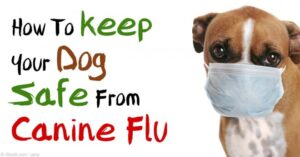🦴 75,000+ Happy Pets • ⭐⭐⭐⭐⭐ 800+ 5-Star Reviews • One Trusted Pack!
Dog flu, or canine influenza virus (CIV), is a pesky respiratory illness in dogs that can make your pup feel pretty miserable. While it’s usually not life threatening, it’s important to know how it spreads, what dog flu symptoms look like, and how to help your furry friend feel better.
What is Canine Influenza Virus?
Canine influenza virus is caused by two strains of the flu virus in dogs: H3N8 and H3N2. The virus affects a dog’s respiratory system and can lead to flu-like symptoms in dogs, much like the flu virus in humans. While humans can’t get canine influenza virus, dog flu transmission happens quickly among dogs, especially in places like kennels, shelters, and dog parks.
How Do Dogs Catch Canine Influenza Virus?
Dog flu transmission is highly contagious and spreads when an infected pup coughs, sneezes, or barks. The virus can also stick around on surfaces like dog toys, water bowls, and even human clothing! Since most dogs don’t have built-in immunity to canine influenza virus, they’re pretty likely to catch it if they’re exposed.
Symptoms of Canine Influenza
If your dog has canine influenza virus, they might show symptoms including:

Most dogs start feeling better in a couple of weeks, but if the canine flu gets worse, it could lead to dog pneumonia, which requires extra medical attention.
How is Canine Influenza Virus Treated?
There’s no cure for canine influenza virus, but you can help your pup feel better by:
Since bacterial infections in dogs can sometimes piggyback on the flu, your vet might prescribe antibiotics for dogs to help fight off any extra infections.
 How to Prevent Canine Influenza
How to Prevent Canine Influenza
Keeping your dog flu-free is all about dog flu prevention! Here’s what you can do:
Get them vaccinated: Dog flu vaccines are available for both strains and are a great idea if your pup is often around other dogs.
Keep things clean: Regularly wash your dog’s bowls, toys, and bedding to minimize germs.
Avoid high-risk areas: If there’s an outbreak, limit visits to places like dog parks, kennels, and grooming salons.
Watch for symptoms: If your dog seems under the weather, keep them away from other dogs and check in with your veterinarian for
canine influenza treatment.
Can Humans Get Dog Flu?
Good news – dog flu in humans isn’t a thing! But since viruses mutate, experts continue to monitor for any potential risks.
Final Thoughts
Even though dog flu isn’t usually serious, it can still make your pup feel pretty crummy. Knowing the signs of canine influenza virus, how to treat dog flu, and ways to prevent canine flu can help keep your four-legged friend happy and healthy. If you think your dog might have canine influenza virus, be sure to reach out to your vet for advice on how to treat the dog flu!
Luckily—so far, there haven’t been any reported outbreaks of canine influenza in the Triangle or Triad areas! That means your pup can still enjoy their favorite hangout spots without worry. But since this virus is highly contagious, it’s always smart to stay alert—especially if your dog loves making new furry friends. Keeping an eye out for any symptoms is a good way to stay ahead of the game. The cold and flu seasons can be tough on both humans and pups, but with a little caution and care, we can help keep everyone healthy and ready to enjoy the sunshine ahead!